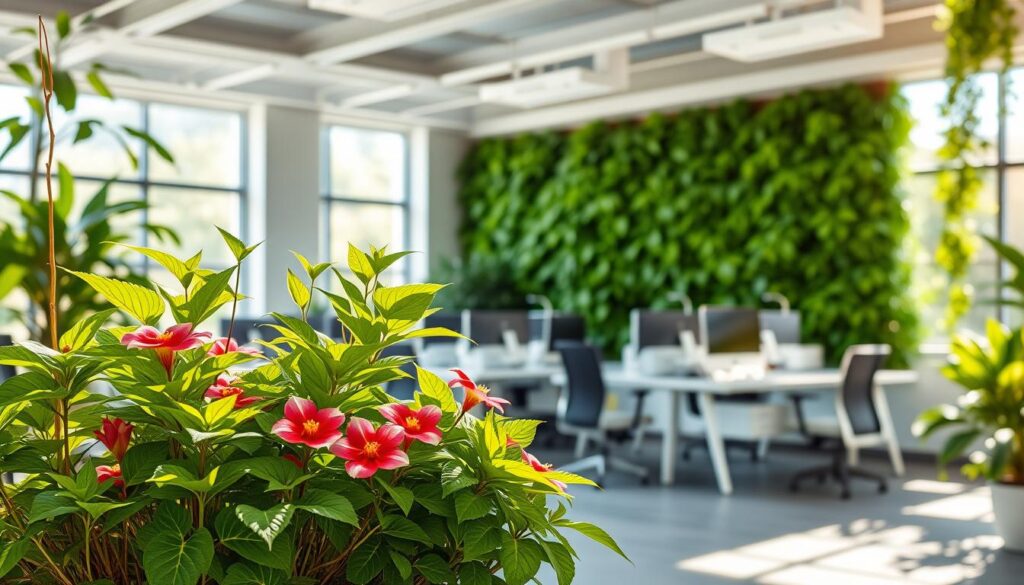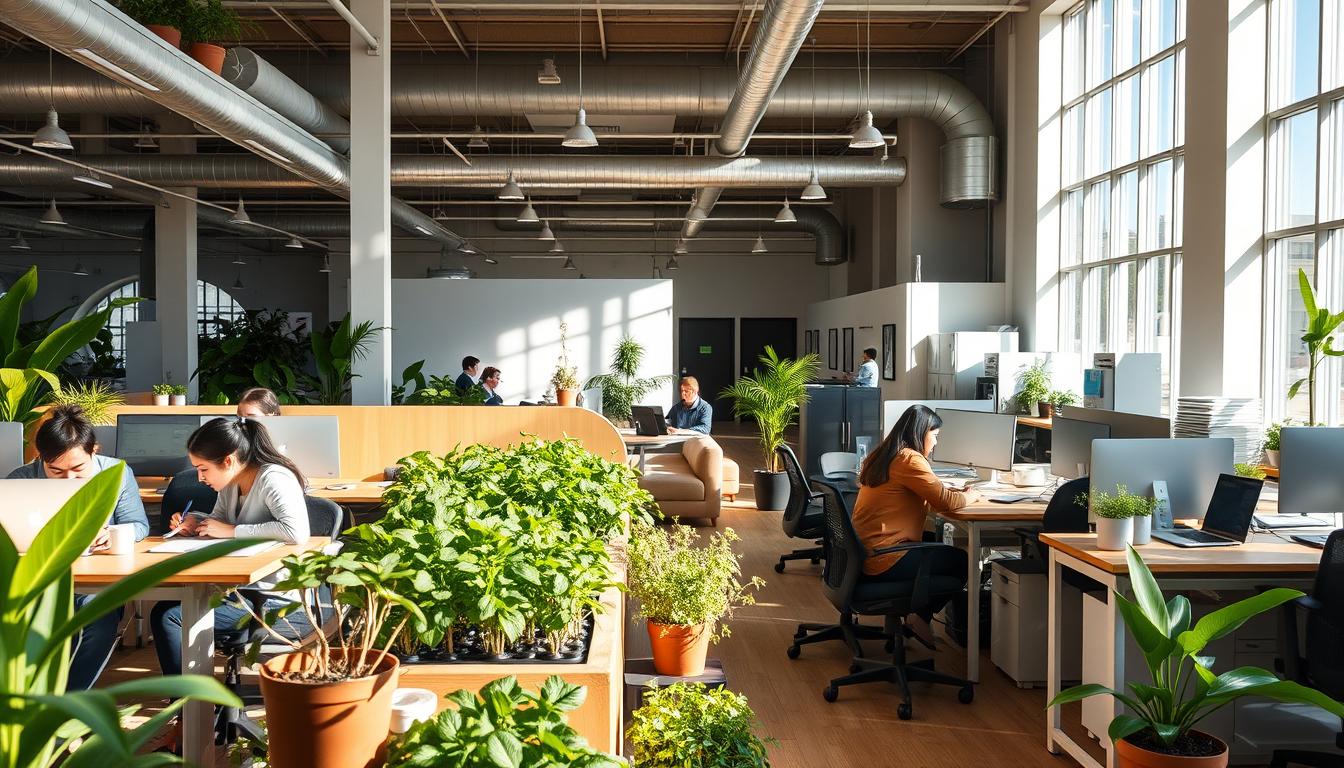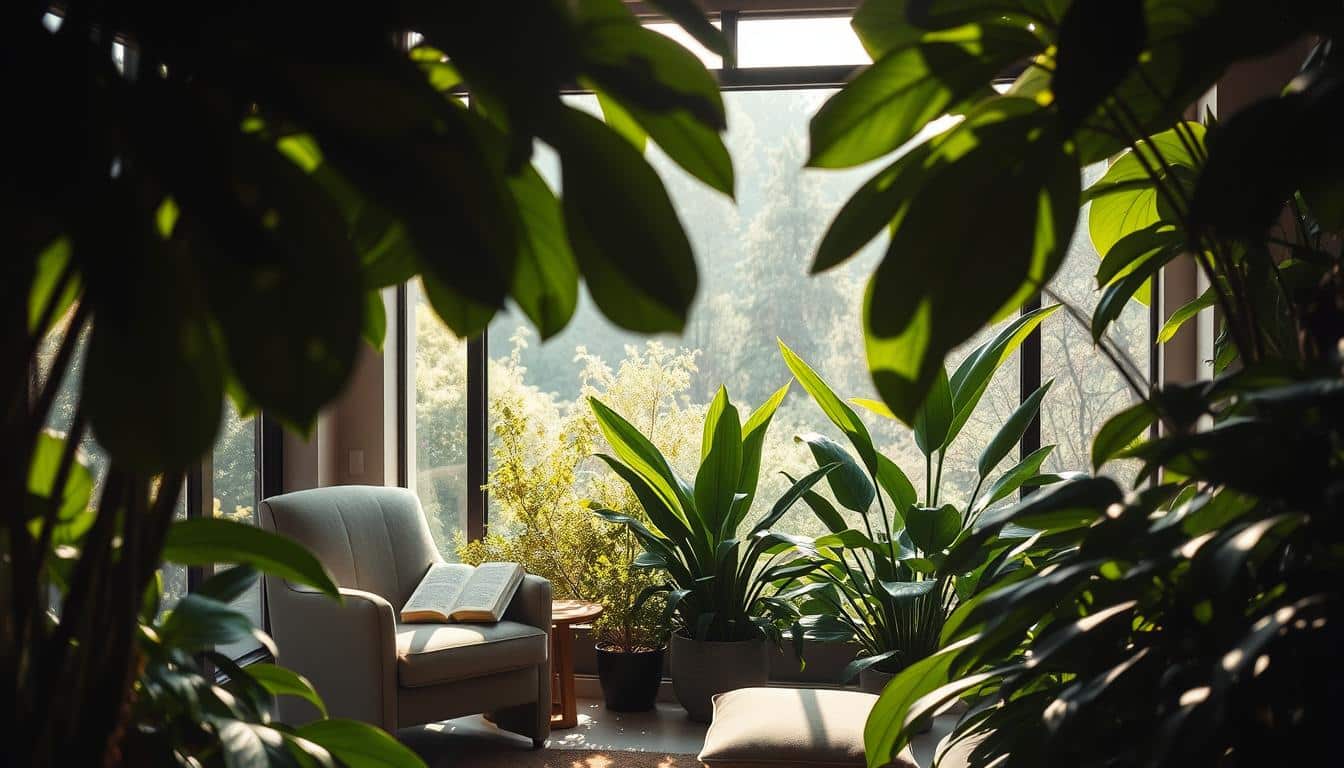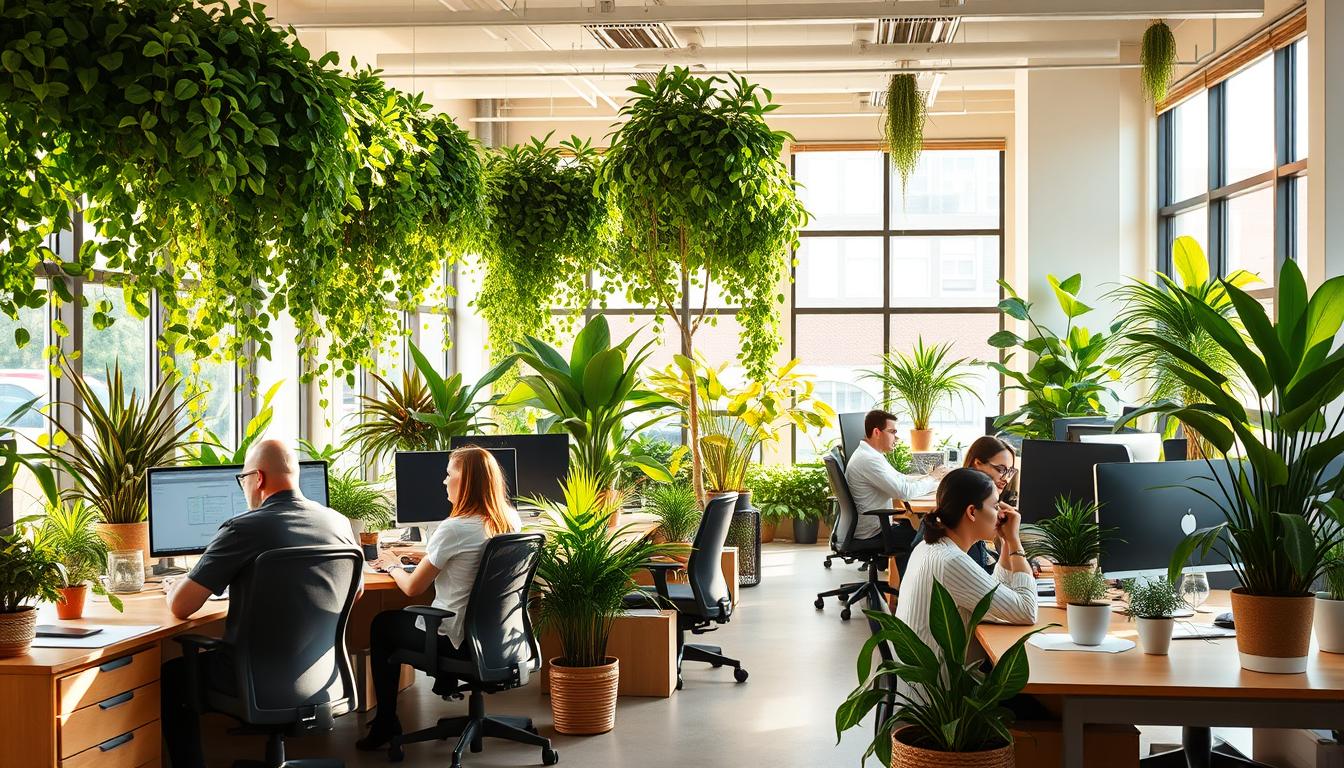Today’s workspaces are transforming by using plant clusters for zoning. These green additions change both the look and the feel of offices. They divide spaces naturally, boosting design and employee well-being. Putting plants in strategic spots can make the atmosphere more productive. It highlights benefits like better air quality and less stress. Let’s explore how cleverly placed plants can change your workspace.
Benefits of Using Plants in Workspace Design
Using plants in workspace design offers many great benefits. It makes for a healthier, more productive space. Let’s look at how plants help improve air quality, lower stress, and increase productivity.
Enhancing Air Quality
Plants like the Spider Plant and Snake Plant are key for better air quality. They clean the air by removing toxins and adding oxygen. This makes the workspace healthier for everyone’s health.
Reducing Stress and Anxiety
Having plants around can really help reduce stress in the office. They create a peaceful atmosphere, helping everyone feel more relaxed. Studies confirm that plants can lower stress, boosting the team’s spirit.
Boosting Productivity and Morale
Adding plants can increase productivity by up to 15%. They help employees focus and feel better at work. This leads to a team that’s more driven and happy.

Understanding Workspace Zoning
Workspace zoning means dividing an office into areas for different tasks. This makes working together and alone better. It includes areas for focused work, team projects, and relaxing.
Designated areas help people naturally talk and work together. For example, spaces for team meetings encourage sharing ideas. Quiet areas allow for focused work without distractions. Thinking about the layout and sound in these areas is key.
A good office layout helps employees and the business. It makes the environment organized and nice to look at. Mixing different zones well can make people happier and more productive at work.
Plant Clusters for Workspace Zoning
Adding groups of plants to workspace design can make a big difference.
It divides the space naturally and increases focus. Greenery makes work areas both useful and beautiful.
Creating Natural Divisions
Plant clusters act as natural barriers for different work zones. This lets you avoid using regular partitions.
Tall plants, like Ficus and Monstera, provide privacy and add beauty. They help to set clear areas in an open office, giving a personal touch.
Improving Focus with Greenery
Plants placed in key areas help people concentrate better. They bring peace and help lower noise. This makes for a quieter workplace.
Workers find it easier to focus on their tasks. Designing workspaces with plants boosts attention and job performance.
Choosing the Right Plants for Workspaces
When you pick plants for your office, it changes the look and feel of the space. Choose plants that do well in different light and are easy to take care of. This will make your office look better and work well for busy people.
Indoor Plants That Thrive in Low Light
Some plants are perfect for areas that don’t get much natural light. The best options include:
- Pothos
- Snake Plant
- ZZ Plant
These plants can handle low light and still look green and lively. They are great for adding beauty to any office, even in spots with not much sunlight.
Low-Maintenance Plant Options
If you want plants that don’t need much care, think about getting:
- Spider Plant
- Cast Iron Plant
These plants don’t need much water or attention, which is perfect for a busy office. They are strong and easy to keep, making them great for any workplace.
Styling Plant Clusters in Office Spaces
Using plants to style an office can make it look better and more lively. The arrangement of plants plays a big role in their look, making each office area both useful and welcoming.
Strategic Placement for Maximum Impact
Placing plants thoughtfully can make different office areas look nicer. Putting groups of plants at entrances makes them feel welcoming. Changing up the heights of plants adds depth and keeps things interesting.
Incorporating Colors and Textures
When picking plants for the office, go for different types to add charm and interest. Plants with colorful leaves or special textures make the workspace more fun, boosting creativity and teamwork.
Incorporating Hanging Plants for Vertical Space
Hanging plants are a smart way to use the space going up in offices with little room. They make the office feel welcoming with their greenery, helping people feel better. Plants like Pothos and English Ivy need little care and add a natural touch to the modern office look.
By placing these plants over desks or in shared spaces, you can brighten up a dull area. They clean the air, making indoors healthier. This creative decoration boosts work focus and helps with relaxation.
Tabletop Plants for Individual Workstations
Tabletop plants make desk areas look better and feel welcoming. They work well in various light conditions. Chinese Evergreens and Mother-in-Law’s Tongue are good choices for most offices. Adding them to your desk brings a bit of nature close to you. This makes your space look nice and feel like it’s truly yours.
Having plants on your desk doesn’t just look good. It helps create a happier workspace. Surrounding ourselves with plants makes us feel relaxed and driven. In big, open offices, plants help mark your own spot. They make your desk feel more private and cozy.
Creating FloorStanding Plant Displays
Floor-standing plants make any office look better. They’re not just pretty. They also help split the space into different areas. By using tall plants like the Fiddle Leaf Fig or Dracaena, the office feels more welcoming and lively.
Adding these plants brings a touch of nature inside. This uplifts both formal and casual settings. They bring in colors and textures, making the office mood better. Plus, different types of plants make the space look interesting and peaceful.
Integrating Plants Into Open Floor Plans
An open floor plan boosts flexibility and teamwork in a shared space. Adding plants makes this design even better. By smartly placing plants, you can make a workplace more productive and private.
Utilizing Space Efficiently
In open spaces, using plants to mark areas makes the space work better. This setup helps keep things organized and easy to move through. Plants make the area look good and work well, without needing walls.
Designing for Collaboration and Privacy
Plants can create soft borders that help people work together but still keep some privacy. Big plants placed carefully can make workspace dividers feel natural. This method makes sure everyone can focus and feel part of the team even in busy spaces.
Maintenance Tips for Office Plants
Keeping office plants healthy and lively requires effective maintenance. Starting a care routine tailored to each plant’s needs will help. These tips highlight important aspects of plant care for your office.
Watering Guidelines
Knowing how to water correctly is key for plants. Different plants need different amounts of water. To avoid too much water, try using self-watering pots. Checking the soil often helps make sure your plants get just the right amount of water.
Light Conditions to Consider
Light is crucial for plant health. Keep an eye on how much light your office gets and move plants as needed for their best growth. Every plant type likes a certain kind of light. Figuring this out can stop plants from wilting and help them grow strong.
Discussing Biophilic Design in the Workplace
Biophilic design is vital for a better workplace. It brings nature’s elements into office spaces. This method shows that being close to nature boosts wellness and work efficiency. Offices look better with natural materials and plants around.
This design helps make workplaces where creativity and mental health grow. Studies prove that places with plants and sunlight reduce stress and boost focus. Here are important parts of biophilic design:
- Introducing greenery such as plants and living walls to enhance the aesthetic appeal.
- Using natural materials like wood, stone, and water features to create calming atmospheres.
- Designing with ample natural light, which helps synchronize circadian rhythms.
Recognizing biophilic design’s benefits can lead to happier, more focused employees. It encourages putting nature first in office design. This builds a teamwork-friendly and creative work culture.
Conclusion
Adding groups of plants to office spaces has greatly improved health and happiness at work. They make the air cleaner and help people feel less stressed. This creates a welcoming place that helps people focus and work together. As workspaces change, it’s key to include plants in our designs.
Plant groups also make the office look better and help people feel happier at work. They feel more connected to their workplace. This leads to a team that’s more engaged and gets more done. So, adding plants is important for creating healthy workspaces as companies grow.
Using plant groups in office design has many benefits. It follows today’s design ideas well. By putting nature first, companies can make their employees’ health and happiness better. This leads to a livelier and more successful office.



